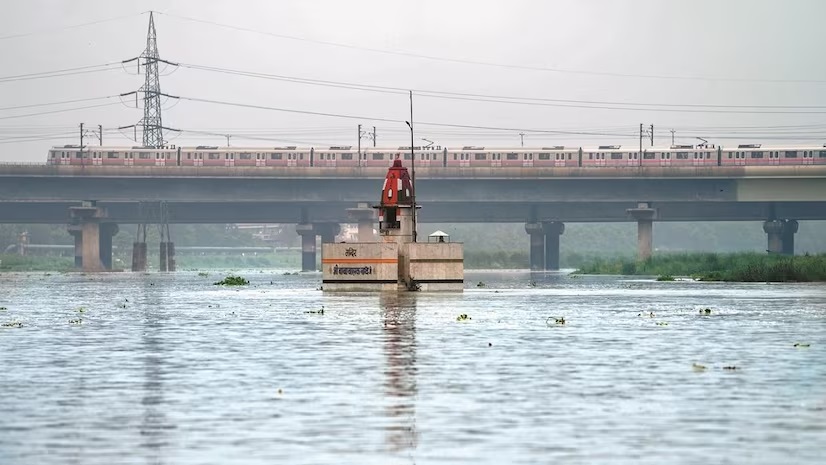
New Delhi- The water level of the Yamuna River in Delhi today dropped below the danger mark of 205.33 metre by 8 pm, the Central Water Commission’s data showed.
The water level showed a slight rise on Monday due to rains in the catchment areas upstream of the national capital.
According to the CWC’s flood-monitoring portal, the water level is expected to drop to 205.15 metre by 7 am tomorrow.
The Wazirabad water treatment plant, where operations were hit due to inundation of a pump house, has also started working at full capacity, Chief Minister Arvind Kejriwal said.
A Delhi Jal Board (DJB) official said the water supply in the city is near normal.
“There is a shortage of only 10-12 million gallons of water per day (MGD) due to inundation of some tube wells in the river floodplains at Palla,” he said.
The DJB extracts around 30 MGD from tube wells installed in the Palla floodplains.
The river has been receding gradually after peaking at 208.66 metre last Thursday. However, a minor fluctuation in the water level cannot be ruled out due to rain in the upper reaches. The inundation of a pump house at Wazirabad due to the swollen Yamuna impeded operations at the Wazirabad, the Chandrawal and the Okhla water treatment plants, leading to a 25 per cent drop in the water supply.
The Okhla plant began operating on Friday, and the one in Chandrawal on Sunday.
“The Wazirabad Water treatment plant has also started working at full capacity. Now all WTPs are working at full capacity. DJB worked very hard. Thank you DJB!” tweeted Kejriwal. Parts of the city have been grappling with waterlogging and flooding issues for a week now.
Initially, a downpour caused intense waterlogging on July 8 and July 9, with the city receiving 125 per cent of its monthly rainfall quota in just two days.
Subsequently, heavy rains in the upper catchment areas, including in Himachal Pradesh, Uttarakhand, and Haryana, led to the Yamuna swelling to record levels.
The river reached 208.66 metre on Thursday, surpassing the previous all-time record of 207.49 metre set in September 1978 by a significant margin.
The river breached embankments and penetrated deeper into the city than it has in over four decades.
Friday marked a turning point as the raging Yamuna and the resulting backflow of foul-smelling water from drains spilt into prominent locations such as the Supreme Court, Raj Ghat, and the bustling intersection at ITO.
Prior to the misery on Friday, the river water had already reached the rear ramparts of the Red Fort and inundated one of the city’s major bus terminals at Kashmere Gate.
The Ring Road, constructed partially over floodplains, remained closed for three consecutive days near Kashmere Gate last week.
With the situation deteriorating every passing hour last week, Kejriwal had urged the Centre to intervene and the Delhi Police imposed Section 144 of the CrPC in flood-prone areas to prevent public movement there.
The Army was called in for the first time since the 2010 floods to repair a broken flow regulator at drain no. 12, the reason behind the flooding in central parts of the capital on Friday.
The consequences of the floods have been devastating with over 26,000 people evacuated from their homes. The losses incurred in terms of property, businesses, and earnings have amounted to crores.
Experts attribute the unprecedented flooding in Delhi to encroachment on floodplains, extreme rainfall occurring within shorter durations, and silt accumulation that raised the riverbed.
The low-lying areas near the river in the northeast, east, central, and southeast districts, inhabited by around 41,000 people, are considered prone to flooding.
A study on “Urban Flooding and its Management” by the Irrigation and Flood Control Department identifies east Delhi under the floodplain region and highly vulnerable to floods.
Despite this, encroachment and development have occurred at a rapid pace in the ecologically sensitive region over the years.
Letters exchanged between the Delhi Forest Department and the primary land-owning agency in the city, Delhi Development Authority, show that 2,480 hectares of land in the Yamuna floodplains have been encroached upon or developed since 2009.
Follow this link to join our WhatsApp group: Join Now
Be Part of Quality Journalism |
Quality journalism takes a lot of time, money and hard work to produce and despite all the hardships we still do it. Our reporters and editors are working overtime in Kashmir and beyond to cover what you care about, break big stories, and expose injustices that can change lives. Today more people are reading Kashmir Observer than ever, but only a handful are paying while advertising revenues are falling fast. |
| ACT NOW |
| MONTHLY | Rs 100 | |
| YEARLY | Rs 1000 | |
| LIFETIME | Rs 10000 | |












